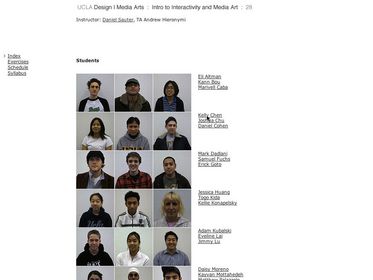Syllabus
UCLA D|MA 28, Winter 2005
Introduction to Interactivity and Media Art
Instructor: Daniel Sauter (dsauter [at] ucla [dot] edu)
TA: Andrew Hieronymi (andrew [at] rhizome [dot] org)
Ten weeks studio course, 2 x 3 hours, outside study 8 hours.
Time: MW 9:00 am ñ 11:50 am Location: Kinross South S122
Office Hours: Daniel Sauter Wednesdays 5-6 pm KINR SO S122; Andrew Hieronymi,
Mondays 5-6 pm ñ Kinross South S122. Office hours by appointments only.
Class website: http://classes.design.ucla.edu/Winter05/28
Description
The word ëinteractivityí is common talk. Used in various contexts, it is often considered as a means to change the passive viewer reception into an active one. This studio course is an introduction to the concept of interactivity
in the context of media art. Interactive artworks often use the act of interaction as a technique of expression and are therefore revealing. The course follows the history of the computer as medium for artistic expression, with the objective to illuminate the various ideas related to interactivity practically and theoretically.
Students are not required to become media artists during this course; rather, in this introductory course, participants will learn basic programming skills, which is a critical step to create interactive works. The concepts and skills
taught in this class will help students to improve their abilities in future classes, dealing with the Internet, animation, game design and interactive media.
There are three types of assignments for this course: exercises, projects and readings. While exercises focus on the specific topics, projects creatively explore particular aspects of interactivity. The complexity of the exercises and projects will increase as the quarter progresses. There will be a critique for each assignment, where participants present their work and receive feedback from the professor
and the class. The process of creating the work, which is equally important as the final outcome, will be documented in a sketchbook and shared periodically with the professor throughout the quarter.
Evaluation:
Exercises and Projects will be evaluated based on their aesthetic and conceptual qualities (80%). Active contribution during class and attendance is required (20%). All assignments must be completed in order to pass the course. Late assignments will reduce the grade by one step for each day. Exercises and Projects are only considered as completed when they are accessible from the course website. Letter grades will be made available trough MyUCLA (http://my.ucla.edu). There will be a sign-up sheet for each class meeting; it is the studentsí responsibility to sign up in this list. More than two unexcused absences (without the teachersí permission before the class meetings) will decrease the final grade by one unit with each additional absence dropping the final grade by another unit.
Exercises and Projects
0: Introduction
1: Form and Motion
2: Form and Interaction
3: Image and Interaction
4: Final Project
Grading
20%: Participation/Contribution, Attendance
30%: Exercises 1 ñ 3
50%: Projects 0 ñ 4
Required Readings (available at UCLA LuValle Bookstore on Campus):
Noah Wardrip-Fruin, Nick Montfort, ed.: The New Media Reader. Cambridge and London:
The MIT Press, 2003.
David Rokeby: Transforming Mirrors: Subjectivity and Control in Interactive Media, available online at http://homepage.mac.com/davidrokeby/mirrors.html (link last
checked Jan. 9, 2005).
Further Readings
Daniels, Dieter: Strategies of Interactivity. Available online at: http://www.mediaartnet.org/source-text/65/
(link last checked Jan. 5 2005).
Weibel, Peter: ìThe World as Interface: Toward the Construction of Context-Controlled
Event-Worldsî, in Electronic Culture. Edited by Timothy Druckrey. New York:
Aperture, 1996.
Huhtamo, Erkki: ìCommentaries on Metacommentaries on Interactivityî, in CAD Forum, 4th International Conference on Development and Use of ComputerSystems,
MediaScape, Zagreb.
Dinkla, Sˆke: ìThe History of the Interface in Interactive Artî. Available online at http://www.kenfeingold.com/dinkla_history.html (link last checked Jan. 9, 2005).
